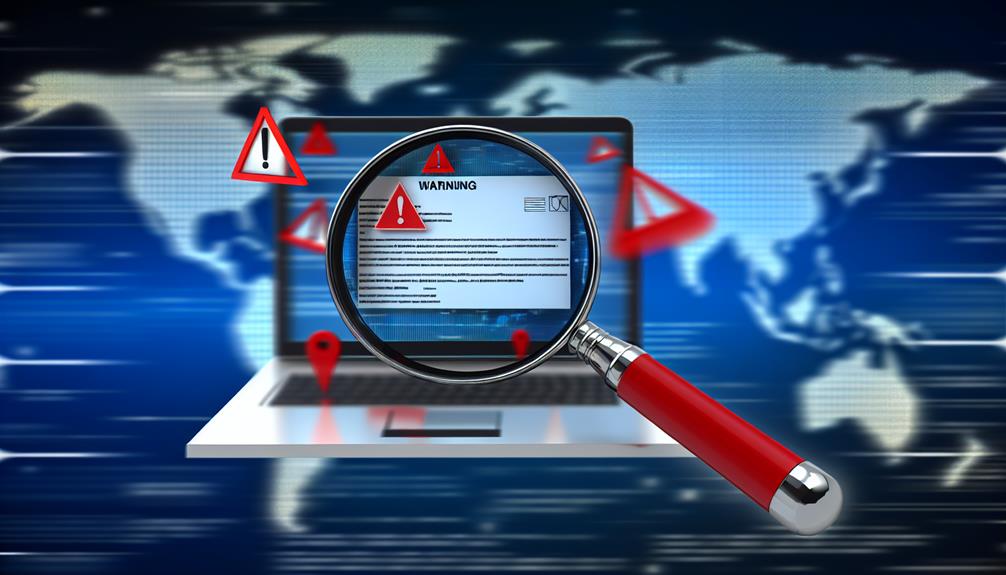You might think that recognizing phishing domains is straightforward, but there's more to it than meets the eye. Understanding the nuances of how to report these deceptive sites and conduct effective checks is critical in today's digital landscape. By familiarizing yourself with best practices and emerging trends, you can greatly enhance your cybersecurity efforts. But what exactly should you be looking for, and how can you guarantee you're not falling victim to these scams? Let's explore the five essential things that could change your approach to phishing prevention.
What is a Phishing Domain?
A phishing domain typically mimics a legitimate site, employing slight alterations to trick you into sharing sensitive information.
You'll notice common characteristics, such as misspellings of recognizable brands or unusual domain extensions that raise red flags.
Understanding these traits is essential for identifying potential threats and protecting your data.
Common Characteristics of Phishing Domains
Phishing domains often present a façade of legitimacy, but they usually share several common characteristics that can reveal their true nature. Understanding these traits is essential for identifying potential phishing attempts and protecting yourself from phishing attacks.
- Use of public email domains (e.g., @gmail.com) instead of unique organizational domains.
- Domain names that closely mimic legitimate ones, often featuring subtle misspellings (e.g., microsfrtfonline.com).
- Links in suspicious emails that redirect to fake websites designed to steal personal information.
- Poor writing quality, including grammatical errors and awkward phrasing.
When you encounter emails that seem suspicious, take a moment to hover over the links to verify the email domain. Scammers often rely on urgency or fear to prompt quick actions without verification.
By employing security tools, you can analyze domain names and assess their legitimacy. Remember that recognizing these common characteristics can greatly reduce your risk of falling victim to phishing attacks.
Stay vigilant, and always verify before clicking or providing any personal information.
How to Report a Domain for Phishing
To report a phishing domain effectively, you need to collect evidence like screenshots, URLs, and email headers that illustrate its malicious nature.
Utilize platforms such as the Anti-Phishing Working Group or dedicated forms from cybersecurity organizations to submit your findings.
Providing detailed context about your interactions with the domain will enhance the investigation and contribute to broader cybersecurity efforts.
Steps to Report a Domain for Phishing
Reporting a domain suspected of phishing requires careful documentation and the use of official channels to guarantee effective action is taken. Start by gathering all relevant details, including the domain name, associated email addresses, and a thorough description of the phishing attempt. This information is essential for the phishing investigation process, enabling authorities to understand the context and severity of the threat.
Next, use official reporting channels, such as the Anti-Phishing Working Group, to submit your report. Make sure to include as much detail as possible, as this aids in swift action. Additionally, many browser security settings allow you to report suspicious websites directly while traversing the internet, enhancing email security and overall safety.
Once you've submitted your report, monitor its status. Investigations may take time, and further information may be requested to bolster the case against potential scammers looking to steal your money.
Platforms for Reporting Phishing Domains
Effective platforms for reporting phishing domains play an essential role in combatting online scams. By utilizing these platforms, you can help enhance cybersecurity and protect yourself and others from malicious sites.
Here are some key options for reporting:
- Anti-Phishing Working Group: Email [email protected] with details about the phishing domains.
- Federal Trade Commission: Forward suspicious emails to ReportFraud.ftc.gov for action against fraud.
- Browser Vendors: Submit reports to Google or Microsoft to block access to phishing content.
- Cybersecurity Firms: Use dedicated platforms from various firms to analyze and report potential phishing domains.
Reporting phishing domains not only aids in immediate threat mitigation but also contributes to wider cybersecurity efforts.
By submitting these reports, you help track and understand emerging phishing trends, making it harder for malicious actors to succeed. Your proactive reporting can lead to significant improvements in online security measures, ensuring a safer digital environment for everyone.
Don't underestimate the impact of your actions in this ongoing battle against phishing scams.
Conducting Domain Phishing Check
To determine if a domain is involved in phishing, you need to verify its legitimacy against known official domains, checking for discrepancies or misspellings.
You can also utilize online tools that assess domain reputation and review registration details for any suspicious activity.
How to Check if Domain is Phishing
A thorough domain phishing check can help you identify potentially fraudulent websites and protect your sensitive information. Start by verifying the sender's email address for slight discrepancies or misspellings that may indicate a spoofed domain. Phishing emails often appear legitimate at first glance, but a closer inspection can reveal suspicious elements.
Next, use online tools to analyze the domain's reputation and check its presence on phishing blacklists. This step is essential in identifying potential fraudulent activity. Hover over links in emails to display the true destination URL, ensuring that it matches the expected domain name and isn't redirecting to a suspicious site.
Additionally, investigate domain registration details through WHOIS lookup services. Phishing domains frequently have recent or private registrations, which can be a red flag.
Finally, look for signs of phishing, such as poor writing quality, urgency, and generic greetings in communications from the domain. These indicators often signal an attempt to compromise your sensitive information.
Tools and Resources for Domain Phishing Checks
While maneuvering through the complexities of domain phishing checks, leveraging the right tools and resources is essential for identifying potential threats.
The following tools can help you effectively combat phishing scams:
- Email Header Analyzers: These tools examine email headers to trace the originating domain and verify authentication methods like SPF, DKIM, and DMARC, vital for identifying phishing attempts.
- Reverse WHOIS Lookup Services: Use these services to gather registration information about an email address's domain. This can reveal the registrant's identity and any associated domains that might indicate suspicious activity.
- Domain Reputation Monitoring: Regularly check domain reputation using online services that score domains based on historical data and user reports. This proactive approach helps you spot potentially malicious domains.
- Phishing Detection APIs: Automate your domain phishing checks by utilizing APIs that cross-reference domains against known phishing databases, thereby improving your efficiency and response time.
Best Practices in Phishing Domain Reporting
When it comes to phishing domain reporting, knowing the best practices can substantially enhance your cybersecurity posture.
You should prioritize certain methods to guarantee effective reporting and verification of suspicious domains. Here are a few key practices to take into account:
- Utilize domain reputation services for legitimacy checks.
- Monitor email domains for spelling and structural discrepancies.
- Leverage automated tools for real-time phishing detection.
- Educate others on the importance of timely reporting.
Frequently Asked Questions about Phishing Domain Reporting
Phishing domain reporting is fundamental in combating cyber threats, and understanding best practices can greatly enhance your organization's defenses. When you encounter a phishing email, it's essential to report it through designated reporting channels provided by your organization or cybersecurity entities. This guarantees your reports are properly addressed and investigated.
Include as much detail as possible in your reports, such as email headers and any suspicious URLs. This information assists investigators in tracing the source of the attack.
Regularly monitor domains associated with emails, as many phishing attempts exploit minor variations of legitimate domain names. By doing this, you can better recognize suspicious domains before interacting with them.
Utilizing domain reputation checking tools is another effective practice. These tools help assess the trustworthiness of a domain, allowing you to identify potential phishing threats before they escalate.
Additionally, educating users within your organization on how to recognize suspicious domains is essential. This knowledge considerably reduces the impact of phishing attacks, empowering users to act decisively and report any threats they encounter.
Check if domain is phishing: Best practices
Identifying phishing domains requires a systematic approach that combines vigilance and the use of analytical tools. To effectively check if a domain is phishing, start by verifying the sender's domain. Look for slight misspellings or unusual domain extensions, as these often indicate phishing attempts.
Next, utilize domain reputation checkers to assess the legitimacy of a domain; many services provide insights into whether a domain has been previously reported for phishing.
When dealing with a phishing email, analyze the email headers to pinpoint the originating server. Confirm the IP address matches the expected domain, as discrepancies can suggest a phishing domain.
Additionally, hover your mouse over any links within the email to reveal the actual URL, confirming it aligns with the legitimate domain of the purported sender.
Be cautious of any suspicious attachments, as these can harbor malware. If you suspect a domain is malicious, don't hesitate to report suspicious domains to relevant authorities and organizations monitoring phishing activities.
Future Trends in Phishing Detection and Reporting
As phishing threats continue to evolve, you'll need to stay ahead of the curve by understanding current trends and expert insights.
Advanced detection systems will increasingly rely on machine learning and threat intelligence sharing, enhancing your organization's ability to respond effectively.
Current Industry Status of Phishing Threats
The landscape of cybersecurity is rapidly evolving, with phishing attacks becoming more sophisticated and prevalent. Currently, 90% of data breaches stem from these tactics, making it vital for organizations to adopt advanced detection methods. As attackers increasingly exploit vulnerabilities in email communications, the risk of identity theft and exposure of sensitive data escalates.
Machine learning and artificial intelligence are gaining traction in phishing detection, enhancing the accuracy of identifying malicious domains and fraudulent emails. These technologies can analyze patterns and adapt to new threats, improving overall security posture.
Additionally, the shift towards remote work has heightened vulnerability, necessitating enhanced training programs that empower employees to recognize and report phishing attempts effectively.
Future trends indicate an integration of automated reporting systems to streamline the flagging and analysis of phishing incidents. Collaboration among cybersecurity organizations is also expected to bolster threat intelligence sharing, facilitating quicker identification and mitigation of emerging phishing domains.
As the industry evolves, staying informed and proactive in implementing these advancements is essential for maintaining robust security against phishing threats.
Expert Opinions on Phishing Prevention
In traversing the complex landscape of phishing prevention, experts emphasize a multifaceted approach that combines technology, training, and collaboration.
As phishing attacks become more sophisticated, organizations must adapt their strategies to effectively combat emerging threats.
Key insights include:
- Leveraging machine learning algorithms to analyze patterns in phishing emails for better detection.
- Implementing enhanced reporting mechanisms for quicker incident responses.
- Encouraging threat intelligence sharing across organizations to identify malicious domains rapidly.
- Focusing on securing personal devices as remote work increases.
Best practices for phishing prevention should include regular training programs that educate employees on identifying phishing attempts, especially those targeting social media platforms.
Incorporating multi-factor authentication can greatly mitigate risks, adding an essential layer of security to sensitive information.
Email filtering technologies are also evolving, utilizing artificial intelligence to stay ahead of phishing tactics.




